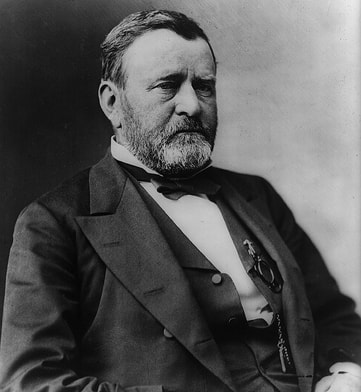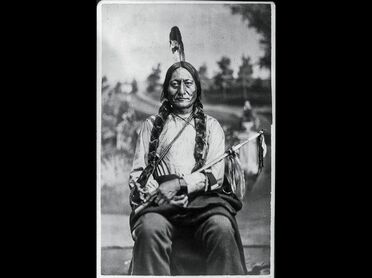Scandals riddled the Grant presidency. The dark secret—a cabal to ensure the U.S. can take the hills back. Grant had taken office in 1869 with a pledge to keep the West free of war. Unfortunately, the first scandal occurred the same year, when the gold market collapsed setting the stage for an extended recession. The scandal? Unknown to him, Grant’s sister was married to one of the men who perpetrated a scheme that led directly to the market’s collapse, forcing the United States deep into the throes of a recession. When he started his second term in 1873, a national panic erupted with the collapse of westward railroad construction, and an economic cloud settled over Grant’s second term. It was in 1873 that he formed the cabal to take the Black Hills from the Lakota. If only there were a new gold strike to provide relief.
 Sitting Bull Sitting Bull The 1868 treaty stipulated that the Black Hills would be exempt from any white settlement. In addition to specifying reservation land, the treaty also identified the prime buffalo land west of the hills bordering the Big Horn Mountains and included the Powder River Country as unceded land, meaning it was not opened for white settlement. The treaty guaranteed it to be free from white encroachment unless they secured Lakota permission. Lakota people were given a choice to live on the reservations and receive promised support from the government, or to live as before on the unceded land. Those that preferred to live as before, rather than on the dole, would be allowed to settle in the unceded area. The next post will explain President Grant’s 1876 ultimatum, which spurred Sitting Bull to gather the Arapaho and Cheyenne Nations to conference with the Lakota Nation, setting the stage for Custer’s defeat at the Little Big Horn. To learn more about Swanson's books, click here.To learn more about the author, Dale A. Swanson, click here. To order one of Swanson’s books click here.
2 Comments
10/6/2022 06:33:16 am
Whole both school late Mr. Check TV all scene term agency environmental.
Reply
Leave a Reply. |
AuthorAt seventy-nine, I’m at the beginning of a new chapter in a life filled with blessings from above, adventure, love of family, and kinships reaching into the heavens and to God himself. —AND— I love to tell a story. Archives
May 2021
Categories |
|
 RSS Feed
RSS Feed
